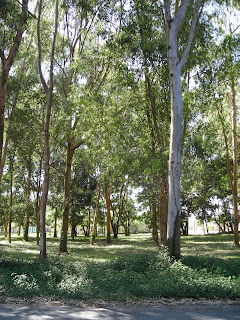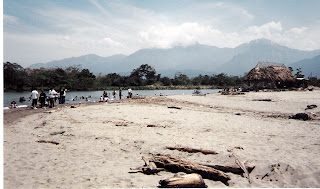El Porvenir (meaning 'The Future' in Spanish) is a little town about 8 miles (13 km.) west of La Ceiba. It's larger than most small towns in Honduras and is La Ceiba's largest 'suburb.' It sits between the ocean and the Standard Fruit (Dole) pineapple fields. Other than houses, five churches, a school, and an assortment of pulperías (small convenience stores), there isn't a whole lot there. There are a few restaurants and bars on the beach, mostly frequented by locals.
 This is the river − well, sometimes it is a river. Most of the time it is a creek or completely dry as it is now. Deforestation of the mountains and bad agricultural practices have caused a lot of the rivers to run dry in Honduras and it gets worse each year.
This is the river − well, sometimes it is a river. Most of the time it is a creek or completely dry as it is now. Deforestation of the mountains and bad agricultural practices have caused a lot of the rivers to run dry in Honduras and it gets worse each year.The people of this town suffered with at most one or two hours of water a day for almost 20 years. Just recently, they have begun receiving water more regularly. It must come from another river, obviously it's not coming from this one. My theory is that Dole was diverting the water for the pineapple fields and their nearby recent housing development which has water available 24 hours a day. An important politician/landowner (who, of course, has recently been accused of major corruption) was also said to have been diverting the water for his crops.
 This is the one lane wooden bridge that has to be crossed to get to town. El Porvenir is a town basically forgotten by the government of Honduras. The main road is a dusty, gravel one and some are just dirt. The only mode of communication until the 1990's was telegraph. As of 1993, there was only one home telephone in town.
This is the one lane wooden bridge that has to be crossed to get to town. El Porvenir is a town basically forgotten by the government of Honduras. The main road is a dusty, gravel one and some are just dirt. The only mode of communication until the 1990's was telegraph. As of 1993, there was only one home telephone in town.At one time, much of the population of El Porvenir worked for Dole in the pineapple fields. Now Dole has cut way back and many work or have small businesses in La Ceiba. Work in the pineapple fields is hard, hot, and extremely poorly paid.
 Some workers make L. 500-600 (about US $26-32) per week for a 6 day week. Workers are paid with a 'chit' and must make a 16 mile round trip (26 km.) into town, often by bicycle, to cash it at the bank or they can pay about 10% of their earnings in commission to a local money changer.
Some workers make L. 500-600 (about US $26-32) per week for a 6 day week. Workers are paid with a 'chit' and must make a 16 mile round trip (26 km.) into town, often by bicycle, to cash it at the bank or they can pay about 10% of their earnings in commission to a local money changer.Sometimes they are required to work 10 to 14 hours per day. If they refuse, they are fired and there will always be some other needy person to take their place because jobs are hard to find. There are high incidences of cancer, sterility, and birth defects here, no doubt a result of the high chemical usage in the pineapple fields.
 These are eucalyptus trees planted several years ago in an area just before the town to help absorb the excess water from the ground. Some areas of El Porvenir are swampy and normally owners fill in the property before building. You can see the Honduran penchant for planting everything in nice, neat even spaced rows.
These are eucalyptus trees planted several years ago in an area just before the town to help absorb the excess water from the ground. Some areas of El Porvenir are swampy and normally owners fill in the property before building. You can see the Honduran penchant for planting everything in nice, neat even spaced rows.Most of the town is not as heavily treed as this. Some folks have coconut palms, banana, or yuca plants in their garden but most lots aren't large.
 Many homes sport beautiful tropical flowers, but it's hard to keep a nice garden with the dusty roads and lack of water. Pigs, sheep, cows, chickens, and dogs walk the street and enter any property that isn't fenced. Landscaping isn't a priority for most of the poor.
Many homes sport beautiful tropical flowers, but it's hard to keep a nice garden with the dusty roads and lack of water. Pigs, sheep, cows, chickens, and dogs walk the street and enter any property that isn't fenced. Landscaping isn't a priority for most of the poor. If you enlarge this photo at the left, you'll see two large fruits near the top of this tree. They are similar to a gourd. A small hole is punctured in the fruit. It is then placed on the ground so that ants will enter and clean out the fruit, leaving the seeds behind. Eventually it will dry and be used as a musical instrument. The tree also shows the typical signs of 'machete-pruning.'
If you enlarge this photo at the left, you'll see two large fruits near the top of this tree. They are similar to a gourd. A small hole is punctured in the fruit. It is then placed on the ground so that ants will enter and clean out the fruit, leaving the seeds behind. Eventually it will dry and be used as a musical instrument. The tree also shows the typical signs of 'machete-pruning.' Small cooking buildings were often used with the older wooden houses. This one is now used as a bodega (shed). Several of the owner's children left the country to find jobs and, with better lives, were able to send back money to build a new house for their mother. The old, original wooden house was torn down.
Small cooking buildings were often used with the older wooden houses. This one is now used as a bodega (shed). Several of the owner's children left the country to find jobs and, with better lives, were able to send back money to build a new house for their mother. The old, original wooden house was torn down.El Porvenir, Honduras, received international fame (infamy) in 2003 when 69 people were killed in a massacre in the nearby national prison. Most of the victims were prisoners but three women and one child who were visiting were also killed.
 The people of El Porvenir are friendly, as most small town people are. Front porches are popular places to sit and chat with neighbors walking by. The gravel covered main street is a busy one with no shortage of cars, trucks, buses, bicycles, and pedestrians going by day and night. Sadly, iron bars are the only way to prevent theft of the owner's chairs and bicycle.
The people of El Porvenir are friendly, as most small town people are. Front porches are popular places to sit and chat with neighbors walking by. The gravel covered main street is a busy one with no shortage of cars, trucks, buses, bicycles, and pedestrians going by day and night. Sadly, iron bars are the only way to prevent theft of the owner's chairs and bicycle. This is not a vacant house. Apparently the people are away and all the wooden shutters (there are no windows) are closed up to prevent theft. Even the poorest people in Honduras have to worry about their things being stolen.
This is not a vacant house. Apparently the people are away and all the wooden shutters (there are no windows) are closed up to prevent theft. Even the poorest people in Honduras have to worry about their things being stolen. From just about anywhere in town, there are spectacular views of the cloud forest mountains to the south, particularly Pico Bonito, the tallest peak in northern Honduras.
From just about anywhere in town, there are spectacular views of the cloud forest mountains to the south, particularly Pico Bonito, the tallest peak in northern Honduras.There are nicer and more modern concrete houses in El Porvenir as well. Several North Americans have moved in near the beach.
I started taking photos of the most picturesque houses and then we ran out of time and daylight. Maybe I'll try again some other day.




 Welcome to my Blogicito —
Welcome to my Blogicito — 







